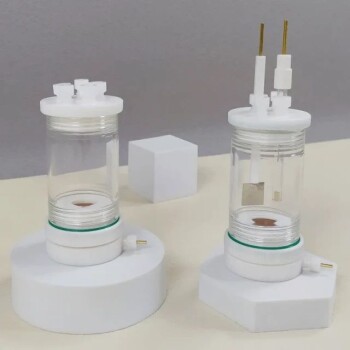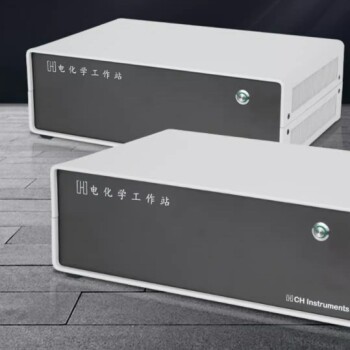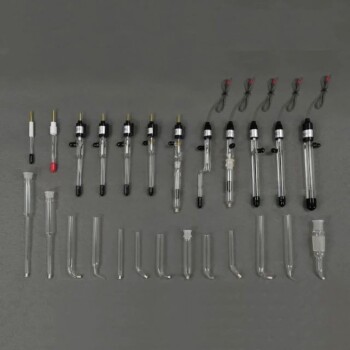An auxiliary electrode is an electrode used in a three-electrode electrochemical cell for voltammetric analysis. It provides a pathway for current flow in the electrochemical cell without passing a significant current through the reference electrode. The most commonly used material for the auxiliary electrode is platinum, due to its inertness. It can be isolated from the working electrode using a glass frit to prevent byproducts generated from contaminating the main test solution. The work of the auxiliary electrode is to pass all the current so that the current at the working electrode can be controlled.
Toggle Categories
Get Instant Support
Choose your preferred way to connect with our team
-
Get Free Quote Fill out form for detailed pricing
-
Send Email Detailed inquiry support
-
WhatsApp Quick mobile chat
Response Time
Within 8 hours on working days, 24 hours on holidays
auxiliary electrode

Multifunctional Electrolytic Electrochemical Cell Water Bath Single Layer Double Layer
Item Number : ELCM
$159.00

Lab Electrochemical Workstation Potentiostat for Laboratory Use
Item Number : KT-CHIP

Reference Electrode Calomel Silver Chloride Mercury Sulfate for Laboratory Use
Item Number : ELERA
$19.90

Platinum Sheet Electrode for Battery Lab Applications
Item Number : BC-09
We have the best Auxiliary Electrode solutions for your electrochemical cell needs. Our extensive range of materials includes electrochemically inert materials such as graphite, gold, carbon, and platinum. The auxiliary electrode is responsible for passing all the current so that the current at the working electrode can be controlled. Our auxiliary electrodes are fabricated from high-quality materials to ensure the accuracy and precision of your electrochemical measurements. We also offer bespoke designs for more unique applications to meet almost any customer requirements.
Applications of Auxiliary Electrode
- Used in a three-electrode electrochemical cell for voltammetric analysis
- Provides a pathway for current flow in the electrochemical cell without passing a significant current through the reference electrode
- Provides a means of applying input potential to the working electrode
- Used to make a connection to the electrolyte for the purpose of applying a current to the working electrode
- Functions as a cathode whenever the working electrode is operating as an anode and vice versa
- Passes all the current so that the current at the working electrode can be controlled
- May be isolated from the working electrode using a glass frit to prevent byproducts generated at the auxiliary electrode from contaminating the main test solution
- Often fabricated from electrochemically inert materials such as gold, platinum, or carbon
- Material used to make an auxiliary electrode must be an inert material like graphite or a noble metal such as gold, carbon, or platinum
- Used to balance the removed or added charge by the working electrode
- Swings to extreme potentials at the solvent window edges where the oxidation or reduction of the solvent occurs
- Divides the role of supplying electrons as well as referencing the potential between two different electrodes
- Does not pass any current in reference electrode
Advantages of Auxiliary Electrode
- Enables controlled current flow in electrochemical cells
- Provides a pathway for current flow without passing a significant current through the reference electrode
- Allows for applying input potential to the working electrode
- Isolates the working electrode from byproducts generated at the auxiliary electrode
- Prevents contamination of the main test solution
- Functions as a cathode whenever the working electrode is operating as an anode and vice versa
- Made from electrochemically inert materials such as gold, platinum, or carbon
- In sealed cell design, it protects the cell against destructive pressure rise during charging
- Allows the potential of the working electrode to be measured against a known reference electrode without compromising the stability of that reference electrode by passing current over it
Our Auxiliary Electrode is a cost-effective solution for your electrochemical testing needs. We offer a wide range of materials, including graphite, gold, platinum, and carbon, to suit your specific requirements. Our custom design service allows you to tailor the electrode shape and size to fit your testing set-up, ensuring accurate and reproducible results.
FAQ
What Is The Function Of Auxiliary Electrode?
What Is The Difference Between Auxiliary And Reference Electrode?
What Materials Are Commonly Used For Auxiliary Electrodes?
How Do Auxiliary Electrodes Affect The Performance Of An Electrochemical Cell?
Why Are Auxiliary Electrodes Necessary In Electrochemical Systems?
Are There Any Limitations Or Considerations When Using Auxiliary Electrodes?
REQUEST A QUOTE
Our professional team will reply to you within one business day. Please feel free to contact us!
Related Articles

The Silent Variable: Engineering Reliability in Electrolytic Cells
Data accuracy depends on equipment integrity. Learn the engineering protocols for maintaining electrolytic cells to prevent systemic error.

The Quiet Architecture of Clarity: Preserving Side-Window Optical Cells
Learn the precise protocols for storing optical electrolytic cells. Prevent thermal degradation, chemical etching, and data drift with expert maintenance strategies.

The Silence of the Seal: Why Electrochemical Precision is a Battle Against the Atmosphere
Precision in electrochemistry isn't just about voltage; it's about isolation. Discover how super-sealed cells defeat contamination and define reproducibility.

The Silent Partner: Why Material Choice in Electrochemistry is a Matter of Trust
Discover why high borosilicate glass and PTFE are the non-negotiable standards for electrolytic cells. A deep dive into material science for precise data.

The Art of the Non-Spontaneous: Precision in Electrolytic Circuits
Mastering the electrolytic cell setup requires more than connecting wires. It demands a systematic approach to polarity, purity, and power control.

Why Your High-Temperature Furnace Elements Keep Failing (And How to Stop It)
Discover the hidden causes of MoSi2 heating element failure, like pesting and chemical attack, and learn how to achieve reliable, repeatable results.

Why Your High-Temperature Furnace Elements Fail: The Critical Difference in Silicon Carbide
Furnace downtime from failing SiC heating elements costs time and money. Discover the critical material difference that ensures reliability in extreme applications.

How to Choose and Optimize Water Circulating Vacuum Pumps for Your Lab
Learn how to choose and optimize water circulating vacuum pumps for lab applications, balancing efficiency and reliability.

Understanding and Selecting the Right Microplates for Laboratory Applications
Guide to choosing microplates based on pore density, materials, colors, well shapes, and surface finishes for various laboratory applications.

Preparation Technologies and Applications of High-Purity Metals
An in-depth look at the definition, preparation technologies, and applications of high-purity metals.

Application, Preparation, and Recovery of Precious Metal Targets in Semiconductor Manufacturing
Discusses the use, preparation, and recycling of precious metal targets in semiconductor manufacturing.

Guide to Reference Electrodes in Electrochemical Measurements
Detailed guide on reference electrodes, their use, maintenance, checking methods, regeneration, storage, and applications.

Glymercury Electrode: Composition, Characteristics, and Applications
An in-depth look at the glymercury electrode, its composition, characteristics, and applications in analytical chemistry.

Use and Care of Reference Electrodes
Detailed guide on the use, calibration, and maintenance of reference electrodes in electrochemical studies.

Design and Application of Reference Electrodes in Lithium Batteries
An in-depth analysis of the design, features, and applications of reference electrodes in lithium batteries.

Understanding Electrodes in Electrochemical Systems: Working, Counter, and Reference Electrodes
An overview of the roles and characteristics of working, counter, and reference electrodes in electrochemical systems.

Design Principle and Application of Reference Electrodes for Lithium Batteries
Discusses the design principles, types, applications, and future directions of reference electrodes in lithium batteries.

Introduction to Rotating Disc Electrodes and Common Electrochemical Applications
An overview of rotating disc electrodes and their applications in various electrochemical studies, including catalyst evaluation, battery research, and corrosion protection.

Electrochemistry Basics: Conditions and Precautions for Using Different Reference Electrodes
A guide on the requirements and conditions for using various reference electrodes in electrochemistry.

Identifying and Addressing Issues with a Bad Reference Electrode in Measurement Systems
This article discusses the signs and solutions for a bad reference electrode in measurement systems, focusing on IR voltage drop, high-frequency artifacts, and methods to identify and save a bad reference electrode.











